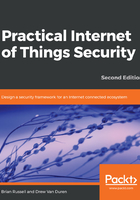
Physical security attacks
Physical security is a topic frequently overlooked by IoT vendors that are only familiar with designing equipment, appliances, and other tools historically not subject to exploitation. Physical security attacks include those in which the attacker(s) physically penetrate the enclosure of a host, embedded device, or other type of IoT computing platform to gain access to its processor, memory devices, and other sensitive components. Once accessed over an exposed interface (for example, JTAG), the attacker can readily access memory, sensitive key material, passwords, configuration data, and a variety of other sensitive parameters. Many of today's security appliances now include extensive protections against physical security attacks. Various tamper evidence controls, tamper response mechanisms (for example, automatic wiping of memory), and other techniques exist to protect devices from physical penetration. Smart card chips, Hardware Security Modules (HSM), and many other types of cryptographic module employ such protections to protect cryptographic variables—hence, device identity and data—from compromise.